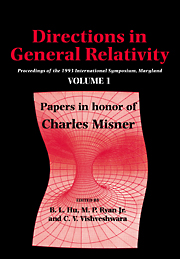 Directions in General Relativity
Directions in General Relativity Published online by Cambridge University Press: 03 February 2010
Abstract
Gravitational radiation antennas have been operating since 1965. A large number of pulses have been observed, coincident on widely separated antennas. These data and the Supernova 1987A observations are reviewed. It is concluded that some of these pulses may have a gravitational radiation origin.
Introduction
The theory of elastic solid, and interferometer gravitational radiation antennas has been under development at the University of Maryland since 1957. Aluminum bar systems have been operating continuously since 1965.
It is very important to stress that the output of a gravitational antenna (and a neutrino detector as well) differs in fundamental ways from the output of an optical telescope.
When an optical telescope collects light from a star, it can be concluded that most of the light came from the star.
A gravitational antenna - bar or interferometer - has electrical output pulses. For a single antenna, there is no way to guarantee that observed pulses are not noise of internal origin or noise from local disturbances such as lightning. If statistically significant numbers of coincident pulses are observed on widely separated antennas, this is evidence that the pulses have a common origin. Directive information is useful but not conclusive, in identifying the source.
There is no way to be certain that such pulses are or are not due to gravitational radiation.
Therefore the statement which is frequently made that gravitational radiation has not yet been observed is meaningless.
To save this book to your Kindle, first ensure [email protected] is added to your Approved Personal Document E-mail List under your Personal Document Settings on the Manage Your Content and Devices page of your Amazon account. Then enter the ‘name’ part of your Kindle email address below. Find out more about saving to your Kindle.
Note you can select to save to either the @free.kindle.com or @kindle.com variations. ‘@free.kindle.com’ emails are free but can only be saved to your device when it is connected to wi-fi. ‘@kindle.com’ emails can be delivered even when you are not connected to wi-fi, but note that service fees apply.
Find out more about the Kindle Personal Document Service.
To save content items to your account, please confirm that you agree to abide by our usage policies. If this is the first time you use this feature, you will be asked to authorise Cambridge Core to connect with your account. Find out more about saving content to Dropbox.
To save content items to your account, please confirm that you agree to abide by our usage policies. If this is the first time you use this feature, you will be asked to authorise Cambridge Core to connect with your account. Find out more about saving content to Google Drive.